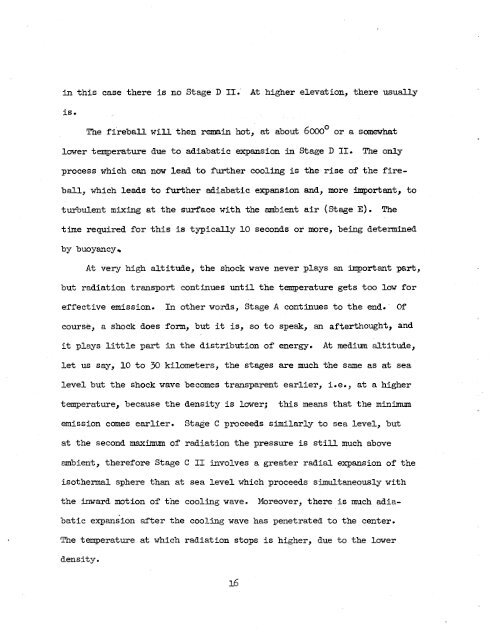Theory of the Fireball
Theory of the Fireball
Theory of the Fireball
You also want an ePaper? Increase the reach of your titles
YUMPU automatically turns print PDFs into web optimized ePapers that Google loves.
in this case <strong>the</strong>re is no Stage D 11.. At higher elevation, <strong>the</strong>re usually<br />
is.<br />
The fireball will <strong>the</strong>n remain hot, at about 6000~ or a somewhat<br />
lower temperature due to adiabatic expansion in Stage D I1 . The only<br />
process which can now lead to fur<strong>the</strong>r cooling is <strong>the</strong> rise <strong>of</strong> <strong>the</strong> fire-<br />
ball, which leads to fur<strong>the</strong>r adiabatic expansion and, more important, to<br />
turbulent mixing at <strong>the</strong> surface with <strong>the</strong> ambient air (Stage E) . The<br />
time required for this is typically 10 seconds or more, being determined<br />
by buoyancy<br />
At very high altitude, <strong>the</strong> shock wave never plays an important part,<br />
but radiation transport continues until <strong>the</strong> temperature gets too low for<br />
effective emission. In o<strong>the</strong>r words, Stage A continues to <strong>the</strong> end.' Of<br />
course, a shock does form, but it is, so to speak, an afterthought, and<br />
it plays little part in <strong>the</strong> distribution <strong>of</strong> energy, At medium altitude,<br />
let us say, 10 to 30 kilometers, <strong>the</strong> stages are much <strong>the</strong> same as at sea<br />
level but <strong>the</strong> shock wave becomes transparent earlier, i.e., at a higher<br />
temperature, because <strong>the</strong> density is later; this means that <strong>the</strong> minimum<br />
emission comes earlier. Stage C proceeds similarly to sea level, but<br />
at <strong>the</strong> second maximum <strong>of</strong> radiation <strong>the</strong> pressure is still much above<br />
ambient, <strong>the</strong>refore Stage C I1 involves a greater radial expansion <strong>of</strong> <strong>the</strong><br />
iso<strong>the</strong>rmal sphere than at sea level which proceeds simultaneously with<br />
<strong>the</strong> inward motion <strong>of</strong> <strong>the</strong> cooling wave. Moreover, <strong>the</strong>re is much adia-<br />
16
















